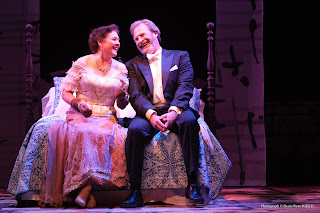2010 silver medalist Soyoung Yoon returns for an IVCI recital
 |
| So-Young Yoon played with understanding, emotional commitment. |
The South Korean violinist, now first concertmaster of the Basel (Switzerland) Symphony Orchestra, won the silver medal in the 2010 International Violin Competition of Indianapolis. IVCI engaged her in its current Laureate Series at the Indiana History Center's Basile Theater.
In the first half of her recital with Chih-Yi Chen at the piano, Yoon wore a dark dress with abundant silver glitter, as if to indicate both the virtuoso demands and the serious business of works by Giuseppe Tartini and Sergei Prokofiev. After intermission, she returned in a less glittery dress dominated by swirling red figures against black; that choice communicated both the more relaxed nature of one of the pieces (Johannes Brahms' Sonata No. 2 in A major, op. 100) and the impassioned gypsy character of the other (Maurice Ravel's "Tzigane.")
The legend behind Tartini's "Devil's Trill" Sonata places it among the tantalizingly dream-connected works of art, matched in another genre by S.T. Coleridge's poem "Kubla Khan." An attempt to render a vivid, creative dream lies behind each work, with the extra frisson of satanic inspiration in the Tartini case. Both authors conceded the triggering dream was better than what they were able to set down on paper.
Yoon played the sonata with the surging intensity it deserves. Chen's largely chordal accompaniment, suspended near the end to give way for a spellbinding violin cadenza, suited the violinist's attention to dynamics. The first onslaught of trills at "Allegro energico" could have used a slightly slower tempo to allow their bite to be felt more. Otherwise, everything was superbly judged, crowned by Yoon's splendid account of the cadenza.
Prokofiev's Sonata No. 1 in F minor, op. 80, his most tragic work, was met on its own bleak terms by the Chen-Yoon partnership. Yoon showed off her 1773 Guadagnini instrument's most plangent tone in the low-register opening. The "Allegro brusco" movement that followed could hardly have been more bracing, even disturbing, in its slashing chords and ringing octaves. With this sort of all-out playing at one end of the spectrum, Yoon and Chen made the most of the brief respite that the "Andante" movement offers at the other — gracefully phrased, introspective. The finale was well-knit, with its flowing phrases suggesting the possibility of an uneasy calm that feels more like resignation.
The Brahms sonata is a genial work that emphasized solid, straightforward expressivity. The middle movement was charming and flexibly managed. The graceful finale drew polished playing from both musicians. With "Tzigane," the partnership was tested and came through swimmingly. Tempo changes were alertly coordinated, with the frequent instructions to accelerate, then to pull back a little, then to accelerate again scrupulously carried out. The hectic concluding measures glowed a fiery red, as if to complement Yoon's "Tzigane dress."
The players offered Tchaikovsky's "Valse sentimentale" as an encore more than adequate to restore peace and confirm their mastery.


Comments
Post a Comment